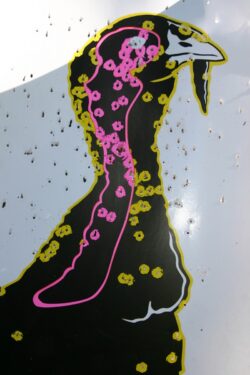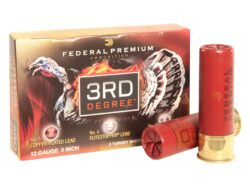 Spring turkey time is just around the corner. Gobblers will be calling hens to mate and welcome new broods of turkeys into a bountiful and healthy environment.
Spring turkey time is just around the corner. Gobblers will be calling hens to mate and welcome new broods of turkeys into a bountiful and healthy environment.
Calling gobblers into shotgun range is a learned skill. Callers mimic owls and gobbles to figure out where the Gobblers are. They then mimic hen calls to invite these wily birds in close for a date. This means 50 yards or closer.
Beyond this range the pattern of shotshell BB’s spreads out beyond fatal, effective range. This is why hunters need to sight in their shotguns.
Not all shotguns shoot the same. Most tend to pattern high and to the right. Beyond 30 yards, they can miss the gobblers head, which is the aimpoint to harvest these birds. The feathered body is tough to penetrate at longer ranges. It takes over 6-9 BBs in the head or neck to effectively kill a big gobbler. Less than that means a crippled and lost bird.
Attaching a scope or sight onto your shotgun helps you to aim. Sight in the gun at 20 yards and adjust the sights or optics as needed. Aim don’t point the gun. Use a rest to keep the gun secure, as you would for a rifle. Sandbags and shoulder pads will help reduce recoil.
 Use the best turkey load that you can find. A buffered load with a full choke is a good place to start. There are a variety of options on the market. Depending on your shotgun gauge, you may select 2 ¾ inch – 3-inch shells. Different brands of shells digest differently in different guns. Find what works best in your gun.
Use the best turkey load that you can find. A buffered load with a full choke is a good place to start. There are a variety of options on the market. Depending on your shotgun gauge, you may select 2 ¾ inch – 3-inch shells. Different brands of shells digest differently in different guns. Find what works best in your gun.
I have found standard 2 ¾ inch shells do just fine withing 50yards. Some hunters swear the most firepower, shot, and boom is required. They also brag about shooting at turkeys beyond 50 yards.
Spring turkey hunting is like Archery elk and deer hunting. You want to get the critter in close and intimate. The closer the better. A strutting gobbler, that is gobbling in close is unforgettable and as exciting as an 800 lb. bull elk at 20 yards. That’s why the weapons are more restrictive. Tagging long range critters is for another time and season.
Use a lifelike turkey target to sight in on. Count the holes in the head and neck. Aim at the neck where the feathers begin and end. The pattern should cover this area and not ruin the edible parts of the bird.
Complete camo and stealth are needed to be a successful Turkey hunter. The bird’s eyesight and hearing are superb. Every part of the turkey hunt is essential. Locating, calling, and accurate shooting are all required. New hunters will bust more opportunities than success. Every mistake will teach you how to become a better hunter.
One thing for sure is that Spring Gobbler season is thrilling and exciting.
Montana Grant
